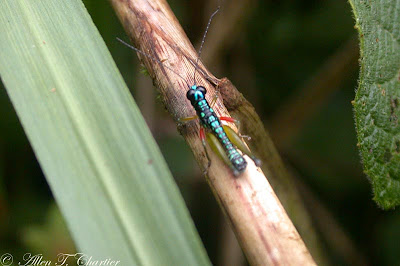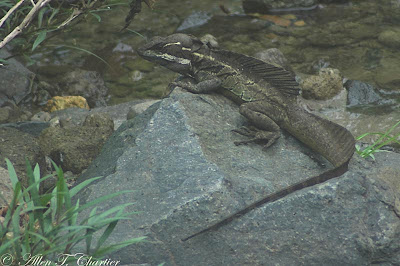The El Valle area is an extinct volcanic caldera surrounded by several peaks. One of those peaks, Cerro Gaital, has been set aside as a natural area. After breakfast, we got into the van and went up to the La Mesa area where we were seeing some open country birds, like this Ruddy Ground-Dove.
At the Cerro Gaital trailhead, the birding was quite good and we took a long time to even get started walking! We saw Blue-throated Toucanet, Orange-bellied Trogon, White-throated Spadebill, Scale-crested Pygmy-Tyrant, Chestnut-capped Brush-Finch, Gray-breasted Wood-Wren, and many others.
On the ground, right in the open near where we parked, there was a common roadside orchid (Epidendrum radicans) that I had seen quite frequently in Costa Rica.
Many of the birds were seen well, but in fairly dense vegetation, and many of them were moving around a lot, like the fast-moving flock of Tawny-crested Tanagers. We walked about the first 1/4 mile of the trail, which was fairly easy walking though entirely up hill.
This female Orange-bellied Trogon was one of few birds this morning that cooperated for photos.
Interesting insects were in evidence, as they were most days. We got better views of a couple butterflies that we'd seen before. This clearwing (probably Ithomia diasa) was the same one we had seen at Cerro Azul on our first day.
And this Togama Stripestreak (Arawacus togarna) gave us better views than the one on the Pipeline Road.
Another butterfly that we'd been seeing, but which hadn't yet cooperated for the camera, was the Forest Giant Owl (Caligo eurilochus) below, named for its large eye spots on the hindwings. These butterflies were huge, with a 6-inch wingspan. We most often encountered them at dawn and dusk as they are more active at those times.
At the other end of the size scale, this leafhopper (Family: Homoptera) was surprisingly cooperative on a blade of grass. Many tropical species are called Sharpshooters.
A splash of color is always a pleasant surprise, and when it is on a small (1/2 inch) grasshopper it is even more unexpected. I have seen similar colorful grasshoppers in the tropics before, but have never been able to identify any of them. In Costa Rica, there is a similar species that some (on-line) have been calling the "Tutti-Frutti Grasshopper".
We returned to the Canopy Lodge for lunch. One of the testaments to how well Raul has designed this place is the bathroom he built right off the main lounge/dining area, which allows birders to use the facilities one last time before departing on a field trip without having to go back to their rooms. And I must say, I have to compliment his choice of plumbing fixtures too! If there had been one of these in the souvenir shop, I would have bought one for sure.
After lunch, I spent a little time chasing the local (and rather tame) Rufous Motmot around, trying to get a photo of him NOT on the feeder. But he liked the shadows, making photography difficult.
And I managed a few photos of one of the other common local hummingbirds, the Rufous-tailed Hummingbird, which seemed to prefer the Vervain flowers instead of the feeders.
When the sun peeked out for a moment, this large dragonfly made an appearance, allowing me only a couple photos from the rear before it darted off to parts unknown.
With the brief moment of sun for encouragement, and a couple hours to kill before our afternoon field trip departed, four of us decided to get a ride down into El Valle to the famous Sunday market. The other three of us decided to walk back up the hill to Chorro el Macho to look for an owl that could sometimes be found on a day roost. We all should have known better, as the now dependable early afternoon rain came with a vengeance. Those who went to the market could stay dry under shelters. Those of us who walked got completely soaked and nearly got washed down the road in the torrential rain.
Our afternoon field trip departed late, as the rain continued later. With the rain letting up, we arrived at the Cara Iguana Trail just outside the town of El Valle. The birding here was slow, as the rain hadn't completely let up yet and the forest was dimly lit. But, sharp-eyed Stella saw one of our target birds, without the aid of a tape. She quietly asked, what is this bird on the ground with an orange breast, black back, and white eyeline? Rosy Thrush-Tanager! A male and female! These very, very shy terrestrial birds cooperated nicely for us by sitting a few feet up in a shrub allowing scope views for all. Another skulker was found along this trail, and Tino managed to coax one of the two Gray-necked Wood-Rails into running across the road in front of us. These great experiences will be etched in our memory, as they didn't get recorded in photos. All I managed was a photo of yet another toad, this one may possibly be a Southern Rough-gland Toad (Bufo coccifer). I'm open to corrections of any identifications here...
When we were at the Canopy Tower, a couple other guests who had come from the Canopy Lodge told us that bats could be seen at night at the hummingbird feeders. For some reason, since our arrival, they had been taking the feeders down at night, so I asked Raul if they could leave them up, which they did. It was an interesting spectacle during dinner to watch the bats come in and quickly take a drink from the feeder. After dinner, I set up my camera and tried to get a flash photo of the bats feeding. Raul has told me that these are Long-tongued Bats, and two species are possible here, Glossophaga commissiari and Glossophaga soricina. Based on information in books and on-line, G. commissiari would seem more likely in the denser forest surrounding the Canopy Lodge, but this is just a guess. I took about 50 photos, hoping to just get a bat in view during the fraction of a second that they came in. Their behavior was very similar to what is observed at hummingbird feeders in the daytime, with bats coming in on a schedule, and with disputes and chases. Below is the one useable photo I managed to obtain.










































































